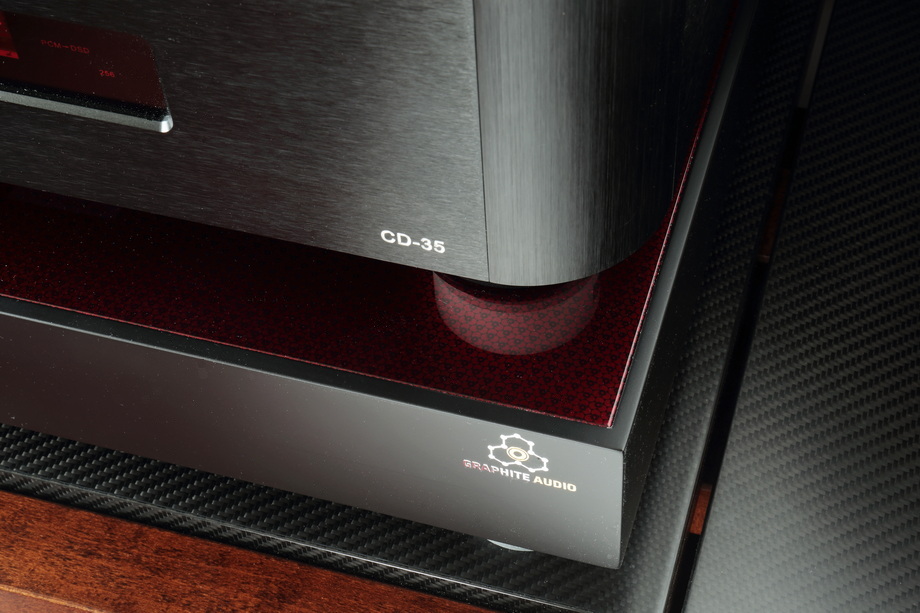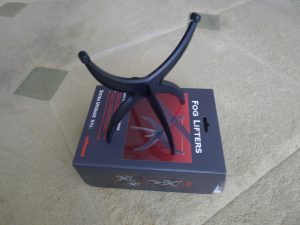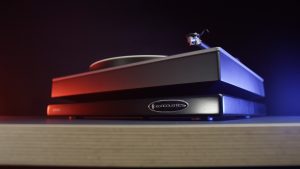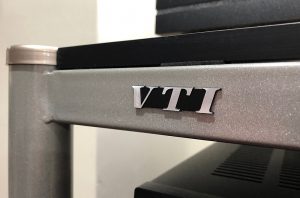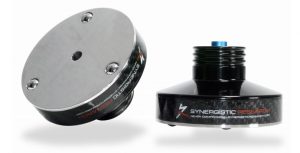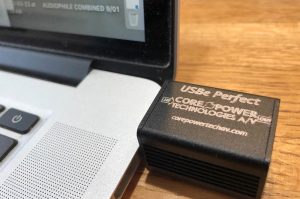Graphite Audio is a young Polish brand, established in 2020 after many years of work on successive anti-vibration solutions. Its founder and designer is Szymon Rutkowski. The company offers isolation platforms, cones, speaker spike bases and cable isolation stands. This is a premiere test of the Classic 100 Ultra platform.
The High End Exhibition in Munich is a kind of sieve that catches companies ready to make their mark in real business from the murky waters of audio. It's all about money, of course, but also—and equally—about the company's vision of development. These two things are not, historically, the strengths of our industry. And that's because audio specialists are almost always enthusiasts, usually starting with DIY products that they decide to commercialize at some point. In other industries, there are extensive startup programs for them, funding these beginnings. No such aid has been offered for companies in the audio industry and some changes have taken place only in the last few years.
Thus, if Polish brands are visible in Munich, it is because they have already achieved international success and they are not start-ups. After all, for years I've seen there hORNS speakers by Łukasz Lewandowski and Pylon Audio speakers by Mateusz Jujka, GigaWatt conditioners by Adam Szubert, Albedo cables by Grzegorz Gierszewski, LampizatOr D/A converters by Łukasz Fikus, Feliks Audio headphone amplifiers by the Feliks brothers, and more recently Ferrum power supplies and converters by Marcin Hamerla, and J. Sikora turntables by Jan Sikora, as well as Fezz Audio amplifiers by the Lachowski brothers. There are other companies as well, but I have recalled the ones I remember best.
This time, i.e., at the High End 2023 exhibition, a few other Polish companies, such as Divine Acoustics by Piotr Gałkowski, BennyAudio by Tomasz Franielczyk, TenToGra by Wojciech Samołyk, Pre-Audio by Daniel Prendecki and the subject of this test, Graphite Audio, have shown their products for the first or second time (exhibition report HERE PL).
Graphite
The company, set up in 2020, has a good idea of itself. From time to time we remind you that identity, i.e., something that differentiates you from competition, is key to a company's market presence. Because, let's face it, manufacturers focusing, for example, on eliminating vibrations in audio systems are a dime a dozen on the market, so to speak, and standing out among them is not easy, and it will get even more difficult. That's why focusing on one material, graphite, which is part of polymers used by the manufacturer, naming the company in this way and composing its logotype after the molecule of this element, was a beautiful start.
Let me remind you that graphite is one of the four allotropic varieties of carbon, next to diamond, fullerenes and graphene. Without going deep into the details, let's go over the basics as described on the Polish Integrated Educational Platform (Pol. ZIE – Zintegrowana Platforma Edukacyjna):
Graphite forms the most stable form of carbon. Its structure is made up of flat layers stacked one above the other. Each layer resembles a honeycomb structure. Carbon atoms are arranged in regular hexagons with shared sides. Within each layer, the atoms are connected by strong covalent bonds to three neighboring atoms of the element. In contrast, there are only weak (van der Waals) interactions between the layers, so graphite crystals are soft and can be easily split.
Distances between the planes are almost 2.5 times greater than bond lengths between carbon atoms in the rings, thus bond strength between the layers is low. Therefore, individual layers of graphite are relatively easy to separate, which we take advantage of every time we press a pencil against a piece of paper.
ZPE.gov.pl https://zpe.gov.pl/a/odmiany-wegla-pierwiastkowego/D8mRW9Ag8, accessed: 2.06.2023.
The Polish manufacturer took advantage of its special mechanical properties, i.e., unusual softness, high pressure resistance and, on the other hand, high tensile strength. High thermal conductivity is also important, which is highly desirable in products based on dampening vibrations through heat emission. Since the material is very brittle, it cannot be used on its own. The Polish manufacturer therefore chose one of the polymer varieties which is doped with graphite.
Classic 100 Ultra
The first products that the Polish company offered were isolation cones to be used under devices and speakers, which still constitute the core of the product range. The IC-35 is in the form of cones, ϕ 35 mm in diameter and 30 mm high. So, the cones are quite large, even though they don't lift devices very high. The manufacturer also offers appropriate bases for the set, but believes that they work best placed directly on the floor or a table. Another popular model are the ISSB-40 isolation speaker spike bases.
In an email to High Fidelity editors, the manufacturer writes:
First there was work on the right material and composition. Once I was satisfied with the material, which contains graphite in the right proportions, the brand name thanks to the color and composition was a natural choice.
The platforms are its latest products. Four models are available, differing in thickness, finish and type of top plate. The price list opens with the Classic 40 model at €1,999 and ends with the Classic 100 Ultra model at €5,999; the price is increased by the option to finish the platform with natural veneer. We are testing the highest available version with the top in a beautiful burgundy color.
A few simple words with…
Szymon Rutkowski owner, constructor
Graphite Audio owner, Mr. Szymon Rutkowski, with the Classic 40 Ultra platform during the High End 2023 exhibition in Munich.
The Graphite Audio company was established in 2020 after many years of exploring and discovering non-obvious anti-vibration solutions. The main theme in my exploration was to create solutions that provide the most natural and realistic music experience (all the bold has been added by the editor).
After countless tests of products available on the market, which are mainly made of various metals, we focused our attention on plastics and polymers. It took us about five years to find the right blend of ingredients that would not only have the right properties, but most importantly, would get us closer to achieving the most engaging and natural sound possible.
The year 2020, for well-known reasons, was not the easiest for new companies. The lack of exhibitions around the world and various restrictions limited the ability to present products to a wider audience of music lovers and audiophiles. However, Graphite Audio products were noticed and appreciated all around the world. In a short period of time, we managed to create a recognizable brand and already at our first exhibition in Munich, in addition to a dedicated stand, our accessories were present in four rooms of renowned manufacturers. By 2023, Graphite Audio's accessories and platforms were being used in eight rooms.
The High End 2023 exhibition in Munich also witnessed a premiere of the Classic isolation platforms line, where the highest Ultra 100 model was supplied for tests. It took us two years to find a suitable material that would sonically harmonize perfectly with the polymer feet and, in the top version, with the polymer board. We chose top-quality plywood, in which each natural veneer layer is 0.5 mm thick. This means that in the Classic 100 Ultra platform we are dealing with a polymer board integrated with 140 layers of veneer and proprietary alloys. All of this is in line with our policy of not using metal components in our products.
As Mr. Rutkowski says, the name of the Classic line "stems from the universal design that fits into any interior." The tested platform measures 495 x 465 x 100 mm and weighs 150 kg. Its lifting capacity is calculated at 220 kg, and the area on which the device (speakers) can be placed is 480 x 450 mm. The platform looks like a million dollars.
This is another Polish product of this type, which is perfectly developed in terms of workmanship, finishing, but above all artistic design. This is because the Ultra version has the form of a box into which the actual platform is inserted from the top. In fact, the two elements work together, and vibration reduction is also aided by four cones, screwed in from the bottom. In Munich, the designer made a point of testing the platform with and without the included bases. Using these bases or not allows one, as he put it, to adjust sound to our preferences and system.
Graphite Audio's platforms are uncoupled. They produce vibrations in the form of heat which is dissipated through appropriate material selection and mass redistribution. All the platforms are in line with Graphite Audio's philosophy, which is summarized shortly as "non-metallic design". The idea is that it does not use metal or ceramic components, in which it differs fundamentally from the product range of Finite Elemente, Pro Audio Bono, Franc Audio Accessories, GigaWatt, Harmonix, Kryna or TiGLON.
From the design perspective, each platform can be broken down into further consecutive elements:
• polymer feet embedded in sockets made of the same material,
• 70 mm board made from "top-quality special plywood" with 140 layers of natural thin veneer, veneer RAL palette or natural veneer, in the Ultra version, there is an additionally protected polymer board in the Ultra Red or Ultra Grey color with an applied pattern that is a mosaic of the brand logo.
The designer, as it is a small specialized manufacturer, prefers not to reveal the method of protecting the fantastic-looking polymer board. As he says, during his first presentation at the Munich exhibition, this finishing method attracted a lot of attention and "a lot of small groups of people would come and have discussions on how to obtain a similar effect."
THE LISTENING SESSION
THE WAY WE LISTENED
The Graphite Audio Classic 100 Ultra isolation platform was tested in the High Fidelity reference system. During the test it stood on its cones with bases on the top shelf of the Finite Elemente Master Reference Pagode Edition Mk II stand. However, I placed the Acoustic Revive RKI-5005 anti-vibration pads under the bases (HERE), so that the whole thing would not slide.
Do I need to tell you that the diameter of the Acoustic Revive pads is identical to the diameter of the Graphite Audio bases? And that it is exactly the same with the discs used by Franc Audio Accessories, and the Finite Elemente Cerabase Classic feet I use under the preamplifier power supply? Probably not. In audio there are certain common ideas, independent of the country.
I leveled the platform using the Bosch PLR 50 C meter. The test consisted of listening to the Ayon Audio CD-35 HF Edition SACD player, which stood on the tested platform, and then was placed directly on the Finite Elemente rack top shelf. The player stood on its own Franc Audio Accessories Classic feet. It was a repeated A/B/A and B/A/B comparison, with known A and B. I was listening both to short fragments (ca.1 min each), as well as whole tracks.
ALBUMS USED IN THE TEST, a selection
Art Pepper, Intensity, Contemporary Records/Universal Music [Japan] UCCO-5114, "Jazz The Best. Legendary 140 | No. 114", CD (1963/2007).
Ornette Coleman, The Shape of Jazz to Come, Atlantic Records/ORG Music ORGM-1081, SACD/CD (1959/2013).
Charlie Haden & Antonio Forcione, Heartplay, Naim naimcd 098, CD (2006).
Elgar, Cello Concerto/Sea Pictures, performed by Jacqueline du Pré, Janet Baker, London Symphony Orchestra, conductor: Sir John Barbirolli, EMI/Esoteric ESSW-90254, "Master Sound Works" series, SACD/CD (1965/2022); HERE.
Jean Michel-Jarre, Electronica 1: The Time Machine, Columbia/Sony Records Int'l SICP
Depeche Mode, Memento Mori, Columbia | Sony Music Labs Inc. SICP-6511, CD (2023).
Laurie Anderson, Homeland, Nonesuch Records 524055-2, CD + DVD (2009), HERE.
Intensity by Art Pepper, album released in 1963 by Contemporary Records, is a Classic example of the genius of Roy DuNann, an American sound engineer. It is free, open, yet close and almost intimate. Since the publishing house was not large and did not have money for its own full-size studio, the recordings had to be made in a record warehouse converted into a recording room for the duration of the sessions. Since it is difficult to talk about the "acoustics" of such an interior, DuNann had to place microphones close to the instruments, a technique reminiscent of that used by Rudy Van Gelder (more about Van Gelder HERE).
The left↔center↔right spacing of instruments, characteristic of that period, was due to the fact that recording consoles at the time did not have potentiometers that changed the position of a given microphone in the panorama smoothly, but three-point switches. The awareness of stereophony was then quite different than today. But here's the thing: the Graphite Audio platform brilliantly demonstrated something that usually escapes with such recordings, namely three-dimensionality within the frames of a given instrument, or—here we have the double bass and percussion in the right channel—a group of instruments.
Before we get to the facts, I will tell you it's a great high-end tool for extracting resolution from recordings. The percussion and double bass had more depth with it and were shown in a more interesting and engaging way than when the player stood on the top shelf of the Finite Elemente rack. While the table itself is excellent, the carbon "Heavy Duty" shelves also do their job. And yet, it can always be better.
The Classic 100 Ultra do what makes high-end high-end: deepen the sound, make it darker, and at the same time open it up. We would say it is a Classic contradiction, because how can something be open and dark at the same time? Students of linguistics and those who liked poetry at school know that such oxymoron's belong to the Baroque period ("cold fire," for example), and that they were about surprising the reader, setting text into "motion," giving it dynamism.
And while this parallel may seem far-fetched, I have it right in front of me, starting about two meters from where I'm sitting. It is because with the platform under the player, the sound was, on the one hand, denser and more concentrated, and, on the other hand, contained more information, thanks to which it seemed to have more meaning. It was simply better differentiated, which also worked out perfectly with another album I listened to: The Shape of Jazz to Come by Ornette Coleman. A different artist, a different label and a different engineer (Bones Howe), yet exactly the same shift.
The opening track Lonely Woman begins with the percussion and double bass playing from a point opposite us, virtually monophonic and quite flat dynamically. My impression is that the bandwidth of both instruments has been severely limited, and the dynamics compressed. However, in a moment, at the extremes of both speakers comes the incredibly energetic saxophone of the leader in the right speaker and Don Cherry's cornet in the left one. They really almost jump out of the speakers, at least compared to Charlie Haden's double bass and Billy Higgins's percussion.
With the platform, the contrast was bigger now, just like the surprisingly loud sounds. But the rhythm section also benefited from it, as it was no longer completely flat, but slightly differentiated. Well, the Finite Elemente rack is excellent, and without the platform in the system I was also completely satisfied with the sound. But audiophilism means constant search and pushing the boundaries of what we thought was possible—just as the Graphite Audio platform does.
Curious about how this change in perspective offered by the Polish platform affects digital, multi-track rock and electronic music recordings, I reached for the Japanese version of the Depeche Mode album Memento Mori. Ordering it in the CD JAPAN store, I was surprised that the album was released on a Classic disc and not on Blu-spec CD2, like all the previous ones by this band. After all, Sony owns the Mute catalog, and in Japan the label releases albums by major artists and major reissues on SACD or Blu-spec CD2. After downloading the obi, everything became clear: the record was pressed in Europe, while the only element that comes from Japan is the obi itself.
However, be that as it may, as time goes by I like this record more and more, and I also appreciate its production more and more. With the Graphite Audio platform under the player, the latter had more color. The sound was richer, and Dave Gahan's vocal was slightly pulled back and surrounded by stronger reverb. Because of this, it was more three-dimensional and vivid. Martin Gore's choruses, spread across the channels and pushed far back into the stage, were also clearer denser, and lower in timbre.
This was also great with Falling, a track from Laurie Anderson's album Homeland. The platform weighted down and enlarged the musical message and released it from a "box." To make things clear, I'm obviously exaggerating. Judged without emotions, the differences may not have been so dramatic. But that's how I emotionally perceived them, as being big. The bass went lower and was more massive with the Polish platform, and spatial information from the stereoscopic bowl around me had more energy with it, which is very hard to achieve, since it relies on low amplitude signals.
Conclusions
The Classic 100 Ultra platform is a perfect product. It offers somewhat different sound than its competitors, although it's generally about the same thing—higher resolution. The Polish platform weighs down the bass and low midrange, as well as enlarges sound sources. However, it also builds a deeper and more three‑dimensional stage, thanks to which this enlargement is not tiring, but interesting—it results in completely new, much better vividness.
It is a top-of-the-range high-end product, which seems to come from a company with years of experience. It's not cheap, but the best products of its kind (Thunder Melody, for example) are also expensive. At the same time, the platform is superbly made, with respect for details and proportions, which is an added advantage.
REFERENCE • High Fidelity
I liked the Polish platform a lot in every respect. So, it has become part of my reference system. Since the size of the Finite Elemente Pagode Edition Mk II rack that I am using was adjusted so that the space between the shelves is not too large, I do not have the option of placing tall platforms on its shelves. So, the Graphite Audio Classic 100 Ultra stood at an equally strategic location, namely under the Audio Revive Ultimate power strip and the Nordost QRT QSource power supply. This is a very important change for me. WP
Graphite Audio
Price (at the time of the test):
- €5,999 (RAL palette)
- €6,629 (natural veneer)
online form: graphiteaudio.com
email: [email protected]
MADE IN POLAND
The tested product was supplied by Graphite Audio
text WOJCIECH PACUŁA
translation Ewa Muszczynko
images High Fidelity




